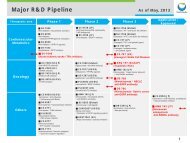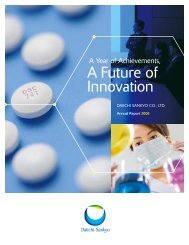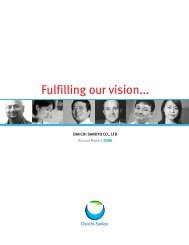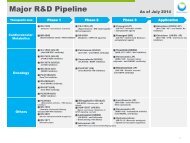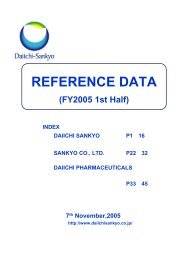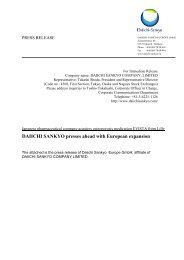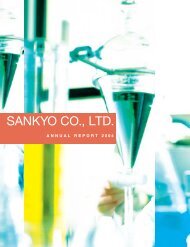Annual Report 2009 - Daiichi Sankyo
Annual Report 2009 - Daiichi Sankyo
Annual Report 2009 - Daiichi Sankyo
Create successful ePaper yourself
Turn your PDF publications into a flip-book with our unique Google optimized e-Paper software.
STRATEGIC MOVE 3: REALIZING THE HYBRID BUSINESS MODEL<br />
Ranbaxy Joins the <strong>Daiichi</strong> <strong>Sankyo</strong> Group<br />
To realize its vision for 2015 of becoming a Global Pharma<br />
Innovator, <strong>Daiichi</strong> <strong>Sankyo</strong> has been implementing its first midterm<br />
business management plan (MTP), which covers the period<br />
from fiscal 2007 through fiscal <strong>2009</strong>. The three-year plan aims to<br />
quickly realize the management integration synergies of <strong>Daiichi</strong><br />
<strong>Sankyo</strong>’s predecessor companies (<strong>Daiichi</strong> Pharmaceutical Co.,<br />
Ltd., and <strong>Sankyo</strong> Co., Ltd.), strengthen drug development capabilities,<br />
reinforce and expand business infrastructure to promote corporate<br />
growth, and attain various other strategic objectives. We<br />
have been implementing diverse measures in accordance with the<br />
MTP. One of these measures is the addition of Ranbaxy Laboratories<br />
Limited to the <strong>Daiichi</strong> <strong>Sankyo</strong> Group. Following the agreement<br />
entered into by <strong>Daiichi</strong> <strong>Sankyo</strong> and Ranbaxy in June 2008,<br />
<strong>Daiichi</strong> <strong>Sankyo</strong> completed its transactions to acquire the majority<br />
of voting rights in Ranbaxy in November 2008.<br />
Established in 1961, Ranbaxy has more than 12,000 employees<br />
and marketing bases in 49 countries throughout the world as well<br />
as manufacturing facilities in India, the United States, and nine<br />
other countries. In 2008, Ranbaxy recorded about Rs73.0 billion<br />
(US$1.68 billion) in consolidated sales* and maintained a wellbalanced<br />
geographic sales structure with significant contributions<br />
from markets such as India, Asia, North America, Europe,<br />
and Commonwealth of Independent States (CIS) countries.<br />
While Ranbaxy is most prominent in the field of generic drugs, it<br />
also has great potential in R&D on innovative drugs. Ranbaxy has<br />
Mr. Atul Sobti<br />
CEO and Managing Director of Ranbaxy Laboratories Limited<br />
several projects in its development pipeline, represented by an<br />
anti-malaria drug that is currently undergoing Phase III trials.<br />
* Calculated based on Indian accounting standards.<br />
Changes in the Global Drug Market<br />
In 2008, the worldwide drug market amounted to approximately<br />
US$773.1 billion, the majority of which was attributable to the<br />
developed countries of North America, Europe, and Japan.<br />
However, expiring patents on blockbusters (drugs with global<br />
annual sales exceeding ¥100 billion) and growing emphasis on<br />
With its executive leadership reconstituted, Ranbaxy will make a<br />
powerful contribution to the hybrid business model.<br />
Hybrid<br />
Business<br />
Model<br />
Developed countries<br />
(Current market size: large)<br />
Innovative<br />
(Proprietary drugs)<br />
Traditional core business<br />
Long-term sellers<br />
(Non-proprietary drugs)<br />
Cost containment<br />
Low growth rate<br />
Emerging countries<br />
(Current market size: small)<br />
Plus<br />
High growth rate<br />
Population increase, economic growth<br />
14<br />
<strong>Daiichi</strong> <strong>Sankyo</strong> Co., Ltd. <strong>Annual</strong> <strong>Report</strong> <strong>2009</strong>




